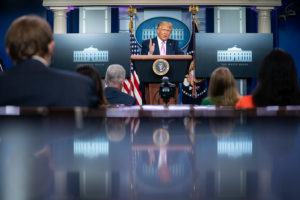
President Donald J. Trump answers a reporter’s question during a press conference Wednesday, Aug. 18, 2020, in the James S. Brady Press Briefing Room of the White House. (Official White House Photo by Tia Dufour)
To keep America great in a lasting way, President Trump’s policy priorities #1 and #2 in a second term should be ending the Fed, and scrapping the personal income tax system in favor of a consumption tax.
1. End the Fed
Ron Paul wrote in End the Fed, “A point we learn from this event [ed note: the 1907 banking panic] and every other banking panic in U.S. history is that crises have always led to greater centralization. A system that is mixed between freedom and the state is a shaky system, and its internal contradictions have been resolved not by tending toward a free market but rather through a trend toward statism.”
A Fed that stuck to its original mandate of lending in a panic at penalty rates is tolerable. A Fed that seeks to tinker with interest rates and the printing press to steer economic growth is quite another. The Fed has enabled the greatest federal deficit on record by printing trillions—in a matter of weeks. It has taken on the role of price setter in the Treasury market, the corporate bond market, and the stock market as well. And that’s just this year.
Over the last 25 years, the Fed has pursued policies that encourage a bubble-bust cycle.
In the late 1990s, to prevent the collapse of Long-Term Capital Management and the Asian financial crisis from creating a wider financial and economic downturn in the U.S., the Fed flooded the system with liquidity. The dotcom bubble escalated on the back of that easy money.
The bubble burst in 2000. The Fed responded by once again flooding the system with money. A real estate bubble ensued. The real estate bubble crashed, and the financial system was in peril. Bernanke dusted off the Fed’s emergency playbook and flooded the system with liquidity, printing money on a scale never seen before.
In the decade following the financial crisis, the Fed started to target asset prices more explicitly. The goal was ostensibly to prevent any meaningful downside correction in stock and bond prices. Emergency monetary policy measures became normal operating procedures. A boom in speculative shares ensued.
The boom turned to bust when COVID hit. The Fed responded by flooding the system with even more money than they had during the financial crisis and took the unprecedented step of intervening in the corporate bond market.
See a pattern here? The Fed’s solution to every bust is to inflate another bubble using more extreme policy than they did in the prior bust. What’s the cost of the Fed’s actions?
Retirement Income 5x as Expensive Because of the Fed
Well, for starters, a more expensive and risker retirement. Long-term treasury rates are now 0.70%. With rates at 4%, $1,000,000 could generate a relatively safe $40,000 per year. To generate that same amount of income at current interest rates takes $5.7 million.
The Fed’s repeated interventions also make the financial system less stable. Every hedge fund in America is asking, “Why not take on more leverage and more risk if the Fed is going to be there to bail me out in a down market?” What about the economy? Growth has been slower in the last 25 years than it was in the prior 25.
In End the Fed, Ron Paul wrote, “Hans Sennholz has called the creation of the Fed “the most dangerous blunder ever committed by Congress.”
It has been 107 years since Congress made that blunder. A fix is long overdue.
2. Ditch the Personal Income Tax
Policy priority #2 should be scrapping the personal income tax system. You can’t meaningfully simplify the tax-code until you take income out of the equation.
The personal income tax system is an overly complicated system that has become one of the most progressive tax structures in the world. The top 1% already pay almost 40% of taxes. The top 20% pays 90% of the taxes, and the bottom 50% pays 3% of the taxes.
It’s not rocket science to figure out that the political class has an incentive to tax the rich as much as they can. In the current environment, the only politically palatable way to increase personal income tax revenue is to raise the marginal income tax rate of high-income Americans. But higher marginal rates discourage work, create distortions, hinder economic growth, and put the burden of taxation on a small portion of the population.
The more pro-growth way to collect taxes is via a consumption tax. If you spend more, you pay more. Higher-income individuals naturally spend more so they will naturally pay more, but everybody from the janitor to the CEO has skin in the game.
A 15% tax on all goods and services would likely be sufficient to cover taxes collected from the personal income tax. The payroll tax would remain. The payroll tax is a simpler and flatter tax meant to be an investment in retirement and payment for future healthcare services.
Tweaks could be made to the 15% rate to allow tax-free spending on groceries and prescription drugs or other necessities, but the initial goal would be to scrap the personal income tax code and move entirely to a consumption tax.
Sound money and a broader, flatter, fairer system of taxation would help keep America great well into the future.




